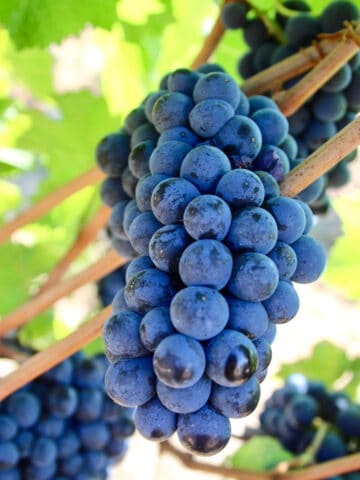They’re both big, bold reds, but each wine of these popular varieties has distinct characteristics. Here are some of the major differences between Cabernet Sauvignon vs Malbec.

Cabernet Sauvignon and Malbec are rich, complex, and among the most well-known red wines. They also share a common French origin. And they make up two of the six Bordeaux red grapes — along with Merlot, Cabernet Franc, Petit Verdot, and Carménère —which are used to create Bordeaux blends.
But Malbec and Cabernet Sauvignon each have unique characteristics that set them apart and have helped make them two of the most popular and beloved varieties among wine enthusiasts.
Let’s take a look at the main differences between Cabernet and Malbec, including tannin levels, aroma, body, and flavor profiles.


Jump to:
The origin of Cabernet Sauvignon
Today, Cabernet Sauvignon is a titan among wine varieties. But this popular wine came about by accident.
Cabernet Sauvignon grapes were first grown in the 17th century in the Bordeaux region of France. It originated as a cross-pollinated hybrid of Cabernet Franc (a red grape) and Sauvignon Blanc (a white grape).
Today, Cabernet Sauvignon has far surpassed those two varieties in terms of acres planted and worldwide consumption. These wine grapes are now the most widely grown in the world.
Top Cabernet Sauvignon wine-growing regions include France, the United States (particularly California and Washington State), Chile, Italy, and South Africa.
The origin of Malbec
France is also the home of Malbec wines and its origin also dates to the Cahors region as far back as the 16th century. But an outbreak of the parasite phylloxera in the 19th century wiped out most of the region’s Malbec vineyards.
The grape variety found a new home in Argentina after vines were brought there in an effort to improve the country’s wines. Malbec thrived in Argentina’s higher-altitude vineyards, especially in the Mendoza region.
Now more than 75% of the world’s Malbec grapes are grown in Argentina. Other growing regions include France, the United States, Chile, and New Zealand.
Flavor characteristics and aroma
Both Cabernet Sauvignon and Malbec are rich and full-flavored, but unique flavor notes and aromas help set these distinct wines apart.
Cabernet Sauvignon

A common taste descriptor for Cabernet Sauvignon is that it is rich in tannins. Tannins are natural substances that add dryness, chalkiness, and astringency to the wine. So it may feel like the wine sort of grips to your tongue as you drink it. Some even describe Cabernet as having a certain chewiness.
Tannins also help give the wine a long finish. So the flavor lingers and can change even after you swallow it.
Good Cabernet Sauvignons are velvety and full-flavored with notes of dark fruit like blackberry, plum, and raspberry. Other common flavor characteristics are more earthy, such as tobacco and leather.
Black fruit also is a strong component when it comes to the aroma of Cabernet Sauvignon, especially for those grown in warmer European regions. You may also detect notes of green peppercorn and dark chocolate.
Other common aromas include raspberry, green bell pepper, and graphite.
Malbec

Malbec tends to have more moderate tannins which cause the wine to be less dry on average than Cabernet Sauvignon.
While they share similar flavor notes including plum, blackberry, and leather, they often are also more grape-forward. That may seem obvious since the wine is made from grapes, but the result can often be a more jammy-tasting wine. Notes of spice and black pepper are also present in many Malbecs.
Malbec usually has a medium, almost sweet finish.
Blueberry and black cherry are common aromas for Malbec. These slightly sweeter fruits help make the wine smell lighter than Cabernet, but it still has a satisfyingly full nose.
Acidity
Acidity is a key aspect of wine as it plays a large role in how it feels and tastes while you drink it.
Wines high in acid tend to coat the sides of your mouth and will taste somewhat tart. Lower-acid wines will feel smoother and softer when you drink them.
Cabernet Sauvignon
Cabs are typically medium-high acidity wines, depending on where they’re grown. Warmer-climate California ones will be lower in acid than those grown in colder regions like South Africa, for example. But generally, Cabs are higher in acid than Malbecs are.
Malbec
Malbec tends to have medium levels of acidity. This results in a rounder mouthfeel and helps even out tannins so they don’t appear as chalky.
As with Cabs, Malbecs grown in cooler regions or at higher altitudes — such as many Argentine Malbecs — will exhibit greater levels of acid.
Body
When it comes to Malbec vs Cabernet Sauvignon, both are full-bodied wines. Though they do have some structural differences.
Cabernet Sauvignon generally has a thicker, fuller body feel than Malbec. With its high tannins, greater chewiness, and longer finish it simply comes across as the heftier wine.
The lower acidity and tannin levels of Malbec, along with its lighter aroma, give the wine a somewhat lighter body overall. It doesn’t grip to the tongue like Cabs can and generally feels softer.
Both have high alcohol contents, ranging from about 13% to 14.5% ABV, which contributes to their more robust bodies.
Color
The colors of each wine resemble their flavor profiles to a large extent.
Cabernet wines are a rich, dark red, similar to the dark fruits that they resemble. This richness in color also contributes to its overall fullness in body.

Just like Malbec tastes jammy, its color is as well. It has a deep purple color with hues of dark red. Malbec’s color, taste, and aroma all work together to form a wine that is both fruity and rich at the same time.
Aging
Cabernet Sauvignon
Cabernet Sauvignon ages particularly well, due in large part to its high tannin levels. Aging will serve to mellow out these tannic wines over time. That means they’ll typically become more velvety and complex as they age.
While many Cab producers make their wine with the intent of selling it more quickly rather than aging it, many high-quality ones age well for up to 10 years.
Malbec
Malbec also ages well, but due to its somewhat softer tannins, the optimal aging period is a bit shorter. Typically, Malbec drinks well after 5 years of aging. But more complex ones can age for longer and result in a great-tasting wine.
Food pairings
You may have heard that big, bold reds go great with red meat like steak. And that’s true when it comes to these two varieties of wine, especially Cabernet Sauvignon.
The rich, intensity of Cabernet Sauvignon pairs exceptionally well with, rich high-fat cuts of meat, like Rib Eye and New York Strip Steak. It also goes well with roast beef and lamb, rich pastas, meatballs, and earthy flavors like stuffed mushrooms.
Malbec’s somewhat lighter body pairs well less-fatty cuts of meat like filet mignon and hanger steak. You may find that it’s also the perfect wine for gamier meats like venison or game birds, as well as fish like roasted salmon and creamier cheeses (like blue cheese).
Price
How does Malbec vs Cabernet compare on price? While you can find good bottles of each wine for under $20, many good-quality Cabs are higher than that, fetching upwards of $50 or more.
Malbec is generally more affordable, with many good bottles in the $15-$30 range.
Malbec vs Cabernet Sauvignon: what’s the difference?
Cabernet Sauvignon
- Primary growing regions: France, United States, Australia
- Worldwide growing acres: 840,000
- Body: Full
- Color: Deep, rich red
- Acidity: Medium
- Flavor notes: Blackberry, plum, raspberry, tobacco, leather.
- Cost: Tend to be more expensive
Malbec
- Primary growing regions: Argentina, France
- Worldwide growing acres: 106,000
- Body: Full to medium
- Color: Deep purple
- Acidity: Medium
- Flavor notes: Plum, blackberry, blueberry, black cherry, jam, and leather
- Cost: Tend to be more affordable
If you like a full-bodied red wine, chances are you’ll enjoy both Cabs and Malbecs. As with any wine, which ones you like will depend on your personal preference and flavor characteristics. Try a variety of them to become more familiar with these different wines. Over time, you’ll likely find some favorites that you go back to again and again.
More wine answers
Have more questions about other popular types of wines? Check out these posts!






Terry says
You confuse tannins with being dry. A common mistake of people who don’t fully understand wine. Dry means a lack of sugar or sweetness. You did a good job of describing tannins except for the dry comment. A common mistake